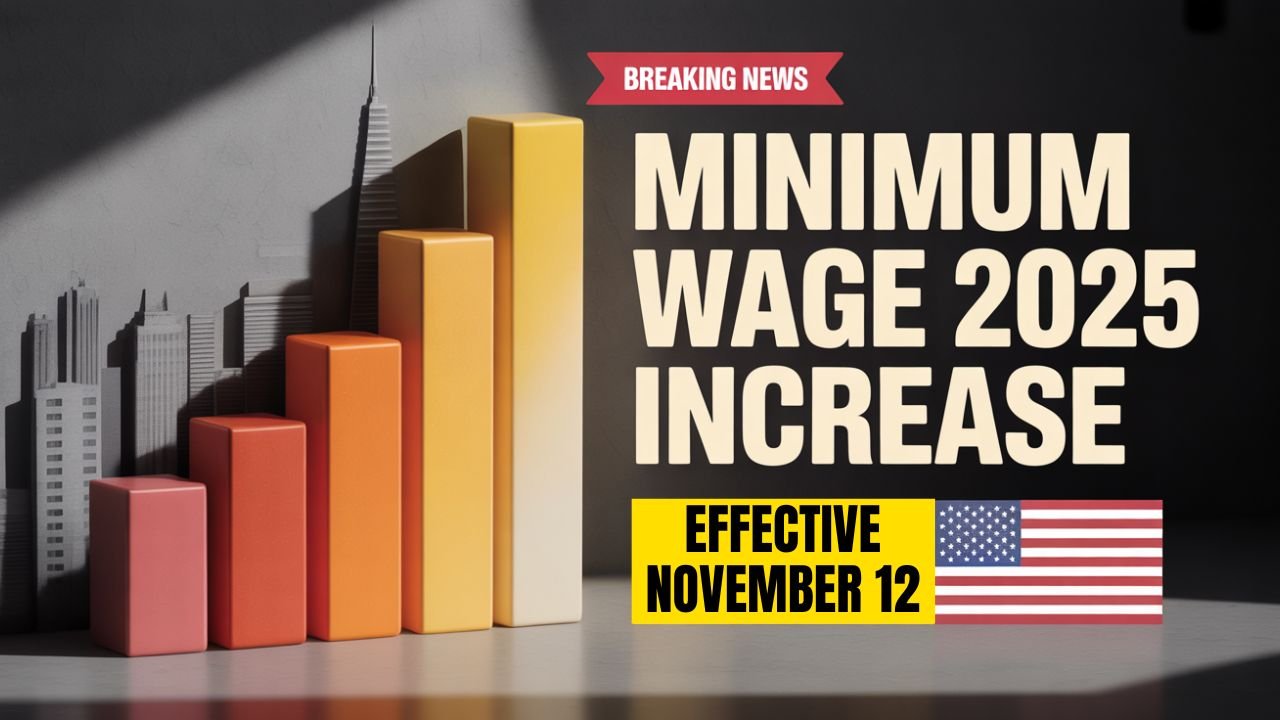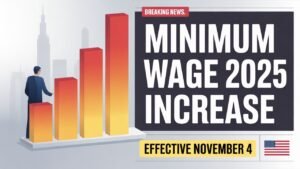U.S. laborers who have been expecting a substantial and long-delayed relief are finally going to get it after more than 15 years. Starting on November 12, 2025, the federal minimum wage in America will be increased officially. This will mark the first adjustment in the minimum wage rate since 2009. The main purpose of this ruling is to reduce the impact of increasing living expenses, secure the workers’ salaries, and boost the economies of the respective regions in the U.S.
A New Beginning for Wage Increases
In a move that marks the end of the longest period of wage stagnation in American modern history, the federal minimum wage rate is going to take a big leap up from $7.25 per hour to $9.50 per hour starting October 2025. Therefore, along with this, the governmental bodies have also set a gradual plan to increase which will lead to a $15 per hour wage by the year 2030. Moreover, the future rate will be automatically linked to both inflation and productivity growth to ensure that the purchasing power of the workers increases along with the time.
Thus, for a worker putting in 40 hours per week, this increase will reflect about $160 more in monthly income and about $2,000 more in annual income. This is a great help to low-income families since they would not have to make a lot of sacrifices just to survive.
Comparison of New and Old Rates
| Category | Previous Rate | New Rate (October 2025) | 2030 Target |
|---|---|---|---|
| General Worker | $7.25/hour | $9.50/hour | $15/hour |
| Tipped Workers | $2.13/hour | $5.50/hour | To be determined |
| Youth Training Wage | $4.25/hour | $8.00/hour | $10/hour |
As per the Department of Labor (DOL) in the U.S., around 27 million employees are now earning less than 15 dollars an hour. The new wage rates will not only affect the income of these workers positively but also make the other wage categories go up due to the fact that the employers will have to align their pay scales with the new rates.
State-level increases also in the pipeline
The federal rate sets only a minimum standard, but several states have announced plans to implement even higher rates. More than half of U.S. states will implement the new, higher wage rates starting in November 2025.
| State | Previous Rate | New Rate (November 2025) | Special Information |
|---|---|---|---|
| California | $16.00 | $17.50 | Higher in some cities (e.g. San Francisco) |
| New York | $16.00 | $17.00 (NYC, Westchester, LI), $16.00 in other areas | Varies by region |
| Florida | $13.00 | $14.00 | Planned to reach $15 by 2026 |
| Washington | $16.28 | $17.25 | One of the highest pay rates in the country |
| Texas | $7.25 | $9.50 | Matches the federal rate for the first time since 2009 |
| Oregon / Illinois / Colorado | $13.50–$15.50 | $14.00–$16.50 | Rates linked to annual inflation |
Seattle, San Francisco, and Washington, D.C. Major cities, such as the U.S., are already paying over $18 per hour, indicating that local policies are catching up faster than federal changes.
Major Relief for Tipped and Young Workers
Among the changes brought about by this legislation, tipped employees in restaurants, bars, and the service industry are the ones who gain the most. The minimum tip they receive, which has been $2.13 for the last 30 years, is going to be increased up to $5.50 now. But, it is still the employer’s responsibility to make sure that the sum of wages and tips does not go below $9.50 an hour.
The wage for trainees who are less than 20 years old has also been raised considerably. That particular rate is raised from $4.25 to $8.00 per hour during the first 90 days, followed by a gradual increase to the standard federal rate.
The intention of these measures is to help the workers in the unstable, low-paying fields with their income made more stable.
Why this change was necessary
In the United States, inflation, housing rents, healthcare, and food prices* have experienced a notable surge in the last few years. Even though productivity has increased, wage growth has been put on hold. Food costs have increased almost 20% compared to the year 2021, and healthcare expenses have also hit the peaks of their historical levels. Under these circumstances, the raising of the minimum wage is regarded as a move to bring back equilibrium.
Supporters believe that:
It will make it easier for employers to meet daily expenses and essential needs.
Opponents’ concerns are that:
- Some small businesses may find it difficult to handle increased payroll costs.
- Wage increases may also lead to higher prices in the service sector.
- Automation may accelerate in some low-paying jobs.
Nevertheless, given these concerns, many states are planning to provide tax credits and temporary financial assistance to small business owners to help them adapt to the new wage structure.
Important Steps for Employers
Before November 12, 2025, all U.S. employers must complete several key tasks:
- Update payroll systems to the new rates.
- Display FLSA minimum wage posters at workplaces.
- Maintain accurate employee time and wage records.
The Department of Labor’s Wage and Hour Division can enforce wage garnishment, fines, or legal action against an employer who does not comply, thus resources at dol.gov/agencies/whd can provide detailed guidance.
The Dawn of a New Era for American Workers
Not just an economic change, but a glimmer of hope for millions of laborers, the minimum wage reform of 2025 has turned out to be an earth-shattering event. The economists regard it as a “national experiment” wherein the aim is to find the fair wage and the sustainable employment at the same time.
If the positive scenario unfolds, the intensity of consumer demand in America will increase, the economic power of neighborhood stores will grow, and families will be financially more secure.
In the end, this hike is not merely an issue of dollars or figures—it is the acknowledgment of the years of strenuous labor of the common American who, through his/her/their labor, makes the nation strong. This is their new chapter—it is the time where every hour of work done will not only be a little more respected but also a little more valuable.
FAQs
Q1. When will the new federal minimum wage take effect?
The new federal minimum wage of $9.50 per hour will take effect on November 12, 2025.
Q2. What is the plan for future increases?
Lawmakers have approved a gradual rise to $15 per hour by 2030, with annual adjustments based on inflation and productivity.
Q3. Who benefits most from this change?
Low-income workers, tipped employees, and young trainees will benefit the most from the increase.
Q4. How much more will full-time workers earn?
A full-time worker (40 hours/week) will earn about $160 more per month, or roughly $2,000 per year.
Q5. What happens if employers don’t comply?
Employers who fail to meet the new wage requirements may face penalties, back pay orders, or legal actions from the Department of Labor.


